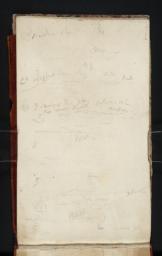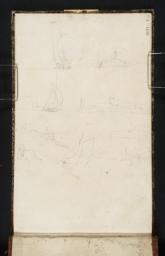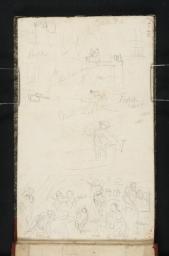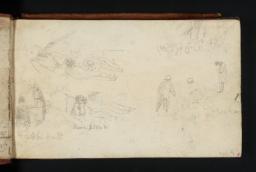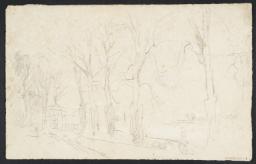The River Thames, London and the South of England 1821–7
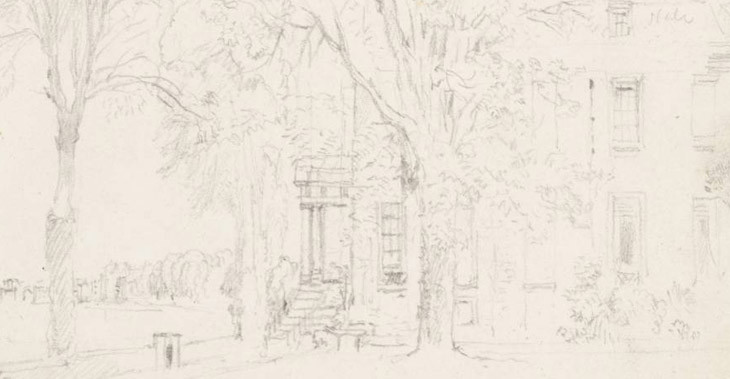
The House and Garden at 'The Limes', Mortlake, Looking North-East down the River Thames 1825
(from the Mortlake and Pulborough sketchbook)
From the entry
While they contain numerous other subjects, the sketchbooks of the 1820s in this section have the River Thames in common. Turner was born and grew up in Covent Garden in central London, a few minutes’ walk from the river, and lived close to it for much of his life, variously at Brentford, Hammersmith, Twickenham and Chelsea, as well as frequenting Margate, at the far reaches of its estuary. For an overview of his work on and around the river in earlier decades, see the introduction to David Blayney Brown’s ‘Thames sketchbooks c.1804–14’ section in the present catalogue. Turner designed and built Sandycombe Lodge purposely not far from the river at Twickenham as his own home, living there, albeit increasingly sporadically, between about 1813 and 1826 (see the present author’s ‘Sandycombe Lodge c.1808–12’ section). Views up the Thames from nearby Richmond Hill occur in various sketchbooks of the later 1810s, culminating in the major painting ...
Mortlake and Pulborough Sketchbook 1821–5
D18706–D18840, D40974, D40984–D40985
Turner Bequest CCXIII 1–91
D18706–D18840, D40974, D40984–D40985
Turner Bequest CCXIII 1–91
References
While they contain numerous other subjects, the sketchbooks of the 1820s in this section have the River Thames in common. Turner was born and grew up in Covent Garden in central London, a few minutes’ walk from the river, and lived close to it for much of his life, variously at Brentford, Hammersmith, Twickenham and Chelsea, as well as frequenting Margate, at the far reaches of its estuary. For an overview of his work on and around the river in earlier decades, see the introduction to David Blayney Brown’s ‘Thames sketchbooks c.1804–14’ section in the present catalogue.1
Turner designed and built Sandycombe Lodge purposely not far from the river at Twickenham as his own home, living there, albeit increasingly sporadically, between about 1813 and 1826 (see the present author’s ‘Sandycombe Lodge c.1808–12’ section). Views up the Thames from nearby Richmond Hill occur in various sketchbooks of the later 1810s, culminating in the major painting England: Richmond Hill, on the Prince Regent’s Birthday (Tate N00502),2 exhibited in 1819; in the present section the River and Thames sketchbooks (Turner Bequest CCIV, CCXII) revisit these bucolic scenes at Richmond, around Isleworth and as far upriver as Henley.
For Turner, the 1820s were characterised by numerous overseas tours, and as a result he travelled less extensively in Britain, of which he had already explored many areas comprehensively. Although they cannot readily be cast as a specific tour or campaign, the London subjects in the sketchbooks here (except for Windsor and St Anne’s Hill; Turner Bequest CCXXV), dating from the early to mid-1820s, have a certain interwoven coherence as the artist continued to depict aspects of the Thames without having to roam far from a busy schedule of work in his London studio. The renewed exploration of the Thames around the familiar, fundamentally medieval ‘Old’ London Bridge coincided with preliminary construction work on its replacement; as Gerald Wilkinson puts it: ‘Old London Bridge had stood uneasily against the flood for six centuries, finally enduring the indignity of having its two central arches made into one.’3 Turner himself had first depicted it as early as 1794 (Tate D00695, D00696; Turner Bequest XXVIII J, K).
In 1821 a parliamentary committee proposed a new bridge, and a competition was held two years later. John (1794–1874) and George Rennie entered a design by their late father, John Rennie (1761–1821), who had already been responsible for both Waterloo and Southwark Bridges. The project was overseen by the younger John (later Sir John), and on 15 March 1824 work began on coffer-dams, each some 50 by 35 metres, constructed of massive timber piles driven nearly 8 metres into the riverbed just upstream of the existing bridge, then drained to enable work on the foundations and lower levels of the piers for the five arches. After some seven years, the new crossing was opened on 1 August 18314 by King William IV. The old bridge was taken down the following year, and the new one demolished in turn in the late 1960s, famously to be transported stone by stone to Lake Havasu City, Arizona; a land arch still stands along Tooley Street on the South Bank.5
Turner showed the earliest stages of work on the coffer-dams in the Old London Bridge sketchbook (Turner Bequest CCV), and apparently returned on the occasion of the Lord Mayor’s Day river pageant of 9 November 1824 to record the piledrivers’ progress in the London Bridge and Portsmouth book (Turner Bequest CCVI) as well as the stately City barges processing to Westminster. His friends Clarkson Stanfield and George Jones both painted the 1831 opening celebrations, respectively from the South Bank and from the roadway of the bridge itself (Guildhall Art Gallery, London; Sir John Soane’s Museum, London). After attending the foundation stone ceremony on 15 June 1825 (as sketched in the Mortlake and Pulborough book; Turner Bequest CCXIII) and taking such interest in the bridge’s progress, Turner was this time away in Scotland, but Jones nevertheless included him in the crowd.6 A contemporary lithograph of the occasion (T11689) provides an unusual view downstream through the arches of the new bridge to the old. In 1833 the precocious painter and engraver Edward William Cooke (1811–1880) published Views of the Old and New London Bridges; there are many of his detailed drawings chronicling the construction and demolition work in the London Metropolitan Archives.
Turner’s sketches appear to have been at least partly motivated by what Eric Shanes has called an ‘“Unknown” London Series’.7 In 1820, W.B. Cooke8 (E.W.’s uncle), who had commissioned work from Turner for other projects such as the ongoing Picturesque Views on the Southern Coast of England series (see the introduction to the ‘West Country 1811’ section of this catalogue)9 instigated a new series of views after Turner and his contemporaries. After a fitful start, the partwork scheme was advertised in The Repository of Arts for August 1824 as ‘Views in London and its environs’, but this coincided with the launch of Hurst and Robinson’s Picturesque Views in London and its environs, and Cooke abandoned his plan, only publishing a print after Turner’s The Custom House, in 1827, as noted below.10
Four of Turner’s watercolours can be linked to the scheme: View of London from Greenwich, of about 1824–5 (Metropolitan Museum of Art, New York);11 the so-called Port of London, dated 1824, (Victoria and Albert Museum, London),12 which was engraved in 1827 as Old London Bridge and Vicinity (Tate impression: T06070); The Tower of London, of about 1825 (private collection), engraved in 1831 for The Literary Souvenir (Tate impression: T06137);13 and The Custom House of about 1825 (Vancouver Art Gallery), engraved in 1827 (Tate impression: T06069).14 Among the material covered in the present section, see the River sketchbook, particularly Tate D17819 (Turner Bequest CCIV 34), for relevant studies of the Tower, while the Old London Bridge book is particularly replete with informative drawings of its title subject.15 Tate D25160 and D25291 (Turner Bequest CCLXIII 38, 169), watercolour studies for the London Bridge view, are covered in a separate section devoted to Cooke’s project.
There are complementary and apparently contemporaneous Thames drawings in the Tabley No.3 sketchbook, including Tate D07063–D07066, D07074, D07083, D07105–D07106 and D07115 (Turner Bequest CV 56a–58, 62, 66a, 77a–78, 83); see David Blayney Brown’s Introduction to that book for further discussion of ‘Views in London and its environs’; owing to some of its contents dating from 1808, it is to be found in the ‘Cheshire, Derbyshire, North Wales ... 1808’ section. As James Hamilton has observed,16 there are other studies of work on the new bridge around 1827 in the Isle of Wight sketchbook (Tate D20751, D20784; Turner Bequest CCXXVII 12, 32a), where its arches are shown in progress, and after its completion in the Mouth of the Thames sketchbook of about 1832 (Tate D27241–D27242; Turner Bequest CCLXXVIII 8a–9)17 and the 1834 Edinburgh sketchbook (Tate D26217; Turner Bequest CCLXVIII 63).
Turner’s Thameside attention was not always focused on modern city life. David Hill has described some of the numerous watercolour subjects in the Thames sketchbook as composed of ‘evanescent washes, almost Chinese in style and ethereal’, suggesting that they are ‘in many respects a way of not engaging with reality, of transcending it, of letting go, of being able to say goodbye’18 to the artist’s time by the still-rural river at Twickenham. The Old London Bridge book includes a sequence of spontaneous monochrome landscapes and skies perhaps influenced by new contact with drawings by Claude Lorrain (c.1604–1682), who was in any case an important influence,19 while the River book includes some ideas for classical subject pictures; this combination of the real and imagined is characteristic of some of Turner’s earlier work along the river, such as the Studies for Pictures: Isleworth sketchbook of about 1804–7 (Tate; Turner Bequest XC).
The London Bridge and Portsmouth sketchbook, as its name suggests, is divided between Thames subjects and a thorough survey of the Portsmouth and Gosport sides of Portsmouth Harbour, which would soon inform three bracing marine watercolours. Also included here in the Mortlake and Pulborough sketchbook are studies for two commissioned views of ‘The Elms’, a house on the Thames at Mortlake, a few miles upriver of central London; the resulting oil paintings were exhibited in 1826 and 1827. As noted above, the book also contains at each end drawings relating to the laying of the foundation stone for the new London Bridge on 15 June 1825, those towards the end apparently showing the elaborate and rather unusual riverbed ceremony itself, suggesting that the Mortlake studies were made soon afterwards. Along with these drawings are views around Petworth House in West Sussex, the home of Turner’s former and future patron Lord Egremont, which also seem likely to have been sketched in the same year as distinct from Turner’s most productive visit to the house and estate in 1827, covered in another section.
Also in this section are studies up the Thames Valley in the Windsor and St Anne’s Hill sketchbook, the two locales of the book’s title relating respectively to a design for the Picturesque Views in England and Wales and illustrations for Samuel Rogers’s Poems. The various sketchbooks thus reflect the richness and wide range of work Turner was still undertaking in these years on English themes between his Continental tours.
It should be noted that the spurious introduction many years ago of two unrelated leaves, now datable to 1821, into the Mortlake and Pulborough book has meant that the overall range of this section has been extended on a technicality to 1821–7, whereas more representative parameters would be about 1823–7.
Martin Butlin and Evelyn Joll, The Paintings of J.M.W. Turner, revised ed., New Haven and London 1984, pp.106–7 no.140, pl.145 (colour).
This account follows ‘London Bridge (1831), site of’, Engineering Timelines, accessed 15 December 2014, http://www.engineering-timelines.com/scripts/engineeringItem.asp?id=664 ; the author is grateful to Tate editor Steve Hare for bringing it to his attention (email 10 December 2014), and for further technical discussions on piledrivers and coffer-dams; see also Hill 1993, p.176 note 79, and Warrell 2014, p.121.
See Helen Dorey, John Soane & JMW Turner: Illuminating a Friendship, exhibition catalogue, Sir John Soane’s Museum, London 2007, pp.16, 17 figs.21 and 22.
See Gillian Forrester, ‘Cooke, William Bernard (1778–1855)’ in Evelyn Joll, Martin Butlin and Luke Herrmann (eds.), The Oxford Companion to J.M.W. Turner, Oxford 2001, p.63.
See also Luke Herrmann, ‘Southern Coast of England, Picturesque Views of [sic] the’ in ibid., p.307.
See Shanes 1990, p.11, summarising the comprehensive account of the scheme and its rivals set out in Shanes 1981, pp.[36]–42; see also Shanes 1990, pp.128–9, 271–2, and Warrell 2014, p.121.
Ibid., pp.358–9 no.516; Wilton also lists a watercolour of ‘London Docks’ (p.359 no.517) as ?1825 and perhaps the same size as the Custom House subject, ‘Provenance and whereabouts unknown’.
How to cite
Matthew Imms, ‘The River Thames, London and the South of England 1821–7’, December 2014, in David Blayney Brown (ed.), J.M.W. Turner: Sketchbooks, Drawings and Watercolours, Tate Research Publication, April 2015, https://www


